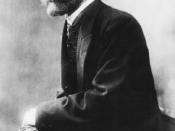Explore Durkheim's contribution to sociological theory
Emile Durkheim was born in France, and is widely regarded as the 'founding father' who put sociology on a professional footing in France in particular, and paved the way for this professionalisation to occur across the rest of Europe. He is now widely regarded as the 'father' of the so-called Structural-Functionalist approach in sociology: an approach developed by the North American sociologists Talcott Parsons, and Roberts Merton.
Durkheim always perceived his objective as establishing the legitimacy of sociology as a science, with it's own protocols and domain. To demonstrate that society can be analysed scientifically, he wrote perhaps his best known work, on suicide. In this he seeks to demonstrate that even a highly individualistic act, such as suicide, has an important social context to it; and that the field of sociology is the best for it's interpretation.
Durkheim's other important contribution to sociological theory, was his work on social values and alienation, and his Functionalist approach to social phenomena, and the division of labour.
The work of Durkheim is now conventionally described as a Functionalist approach to society whereby society is seen as a unity of integrated working parts. The functionalist believes that each part of the whole has a part to play in maintaining the continued existence of the whole, or Society. A functionalist can make an analogy with a machine, in order to illustrate their point, however Durkhiem uses the 'biological analogy', equating complex modern societies with the human body. This biological analogy allows a functionalist, such as Durkheim to make explicit their holistic approach to the study of social phenomenon. Society exists 'Sui Generis'. 'Society' has a life of it's own and beyond the existence of the individuals who inhabit that society. Two further points are made using this analogy.


